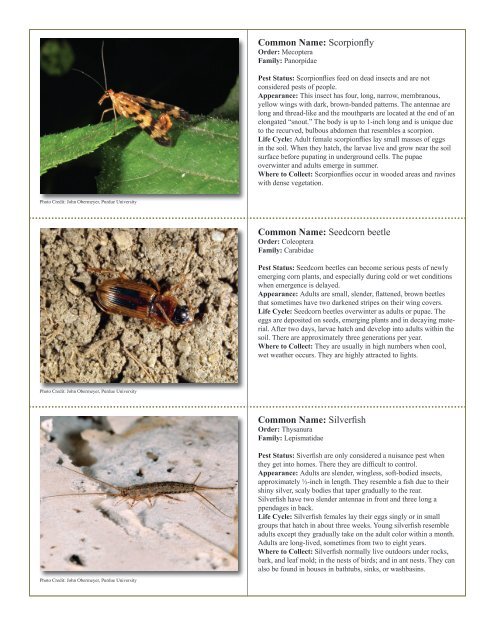to download pdf - Purdue Extension Entomology - Purdue University
to download pdf - Purdue Extension Entomology - Purdue University
to download pdf - Purdue Extension Entomology - Purdue University
Create successful ePaper yourself
Turn your PDF publications into a flip-book with our unique Google optimized e-Paper software.
Common Name: Scorpionfly<br />
Order: Mecoptera<br />
Family: Panorpidae<br />
Pest Status: Scorpionflies feed on dead insects and are not<br />
considered pests of people.<br />
Appearance: This insect has four, long, narrow, membranous,<br />
yellow wings with dark, brown-banded patterns. The antennae are<br />
long and thread-like and the mouthparts are located at the end of an<br />
elongated “snout.” The body is up <strong>to</strong> 1-inch long and is unique due<br />
<strong>to</strong> the recurved, bulbous abdomen that resembles a scorpion.<br />
Life Cycle: Adult female scorpionflies lay small masses of eggs<br />
in the soil. When they hatch, the larvae live and grow near the soil<br />
surface before pupating in underground cells. The pupae<br />
overwinter and adults emerge in summer.<br />
Where <strong>to</strong> Collect: Scorpionflies occur in wooded areas and ravines<br />
with dense vegetation.<br />
Pho<strong>to</strong> Credit: John Obermeyer, <strong>Purdue</strong> <strong>University</strong><br />
Common Name: Seedcorn beetle<br />
Order: Coleoptera<br />
Family: Carabidae<br />
Pest Status: Seedcorn beetles can become serious pests of newly<br />
emerging corn plants, and especially during cold or wet conditions<br />
when emergence is delayed.<br />
Appearance: Adults are small, slender, flattened, brown beetles<br />
that sometimes have two darkened stripes on their wing covers.<br />
Life Cycle: Seedcorn beetles overwinter as adults or pupae. The<br />
eggs are deposited on seeds, emerging plants and in decaying material.<br />
After two days, larvae hatch and develop in<strong>to</strong> adults within the<br />
soil. There are approximately three generations per year.<br />
Where <strong>to</strong> Collect: They are usually in high numbers when cool,<br />
wet weather occurs. They are highly attracted <strong>to</strong> lights.<br />
Pho<strong>to</strong> Credit: John Obermeyer, <strong>Purdue</strong> <strong>University</strong><br />
Common Name: Silverfish<br />
Order: Thysanura<br />
Family: Lepismatidae<br />
Pest Status: Siverfish are only considered a nuisance pest when<br />
they get in<strong>to</strong> homes. There they are difficult <strong>to</strong> control.<br />
Appearance: Adults are slender, wingless, soft-bodied insects,<br />
approximately ½-inch in length. They resemble a fish due <strong>to</strong> their<br />
shiny silver, scaly bodies that taper gradually <strong>to</strong> the rear.<br />
Silverfish have two slender antennae in front and three long a<br />
ppendages in back.<br />
Life Cycle: Silverfish females lay their eggs singly or in small<br />
groups that hatch in about three weeks. Young silverfish resemble<br />
adults except they gradually take on the adult color within a month.<br />
Adults are long-lived, sometimes from two <strong>to</strong> eight years.<br />
Where <strong>to</strong> Collect: Silverfish normally live outdoors under rocks,<br />
bark, and leaf mold; in the nests of birds; and in ant nests. They can<br />
also be found in houses in bathtubs, sinks, or washbasins.<br />
Pho<strong>to</strong> Credit: John Obermeyer, <strong>Purdue</strong> <strong>University</strong>
















